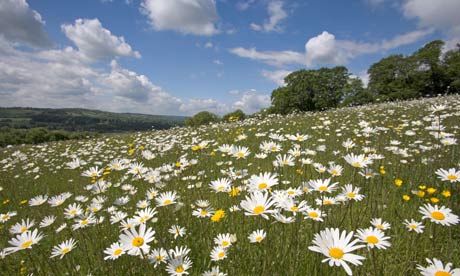
The UK's network of 47 Wildlife Trusts, a voluntary organisation dedicated to protecting wildlife and wild places, is celebrating its centenary this year. Here is its pick of other flower meadows around Britain
Clattinger Farm, Wiltshire
This lovely lowland meadow inspired photographer Barney Wilczak to write an entire book: The Meadow: An English Meadow Through the Seasons, out this month. Hay is cut in July after flowers have seeded, allowing species such as the downy-fruited sedge, burnt orchid and adder's-tongue fern to thrive, and attracting birds such as the reed bunting, pictured opposite.
wiltshirewildlife.org
Aldbury Nowers, Hertfordshire
Aldbury Nowers, above, is on the Chiltern escarpment and adjoins the Ridgeway National Trail, with superb views across the Tring Gap and the Vale of Aylesbury. It was one of the first 284 sites identified for protection by the Wildlife Trusts' founder, Charles Rothschild, 100 years ago. The reserve is one of the county's finest butterfly habitats, with up to 30 species, including the Essex skipper, the marbled white, the green hairstreak, the small tortoiseshell, right, and the rare grizzled and dingy skippers.
hertswildlifetrust.org.uk
Ancells Farm, Hampshire
If you visit this 148-acre reserve between May and July, when the fields are flooded with thousands of rare flowers, you're likely to have it all to yourself. Despite its noisy neighbour (the M3), the site retains a historic feel – small fields are surrounded by ditch and oak bank boundaries, each with their own character and plant composition. The site, half a mile east of Fleet, has been grazed sympathetically for nearly 20 years using highland cattle and horses, and species of note include meadow thistle, pettywhin and dyers greenweed.
hwt.org.uk
Chyverton Nature Reserve , Cornwall
This 10-acre reserve, six miles from Truro, is home to flower-rich meadows and ancient hedgerows. In the past, the site had become overgrown, but through a combination of scrub clearance and grazing, the heathland meadows are now being maintained. Largely unimproved for agricultural purposes, they provide habitats for a diverse range of wildlife. The southern marsh orchid in particular likes wet and marshy ground. Its erect multi-bloomed flower spikes vary from pale pinkish-lilac to deep mauve and can be seen from May to early summer.
cornwallwildlifetrust.org.uk
New Grove Meadows, Gwent
Two gently sloping meadows here have enjoyed an unbroken history of traditional management. In May, early purple orchids appear; by the end of the month the fields are dominated by green-winged orchids. Late June sees the whole field turned pink by a profusion of common spotted orchids. The meadows are four miles south of Monmouth.
gwentwildlife.org
The Wildlife Trust is holding themed weekends this spring and summer to encourage people to enjoy the country's most special environments. As well as meadows, habitats include woodland and wetlands, and there will be walks, talks and family fun events including mini-beast safaris and rockpool rambles.
On 19-20 May a range of "Our History" events will mark the centenary. For example, the Leicestershire and Rutland Trust will host a talk by experts at the Anglian Water Birdwatching Centre, and in Cumbria you can learn about the unique Hutton Roof limestone pavement landscape, but these are just two of many activities on offer.
"Our Meadow Wildlife" (wildlifetrusts.org/whats-on/meadows) on 16-17 June features talks and guided walks at beauty spots such as Chaddesley Wood Meadows in Worcestershire and Stirley Community Farm in Huddersfield, among many others.
On 14-15 July, the focus is "Our Garden Wildlife" (wildlifetrusts.org/whats-on/gardens), including workshops on creating wildlife gardens. Explore Britain's sea animals and plants during National Marine Week (it's actually a fortnight) from 28 July-12 August (wildlifetrusts.org/nationalmarineweek) or find out more about the UK's wetlands on 8-9 September. Contact your local trust for more details of all events.
• For a PDF of 40 places to enjoy wild flowers around the UK, visit (wildlifetrusts.org/wildflowermeadows)

